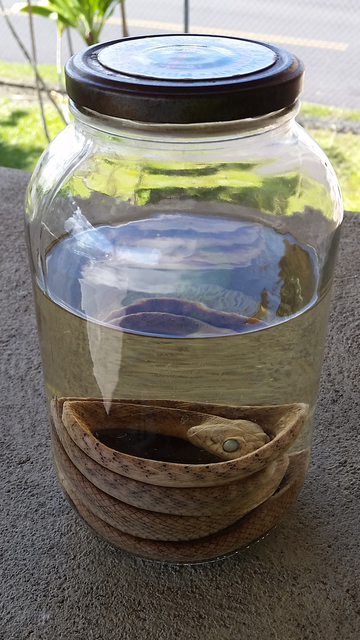Catastrophic. Devastating. Costly. The brown tree snake’s reputation precedes it in Hawaii. Any discussion of biosecurity and invasive species leads eventually to the potential destruction the reptile could cause if introduced to the state.
The draft Hawaii Interagency Biosecurity Plan cites an analysis that found the brown tree snake could cost more than $2.14 billion each year in economic damages.
“You can almost replace any tree-climbing snake, and that would be a problem for island systems,” said Christy Martin of the Hawaii Invasive Species Council. “The brown tree snake simply has a name, and it’s (already) shown an example of what it can do.”
Native to Australia and Papua New Guinea, the brown tree snake was accidentally introduced to Guam after World War II, most likely through transport of military cargo.
Since then it has wreaked havoc on the island’s native vertebrate population, particularly its bird species, and caused multiple extinctions.
Because it is a climbing snake, it affected Guam’s power grid by crawling into transformers and causing blackouts.
There are no cases of people dying from a brown tree snake bite, said Shane Siers, Hawaii field station leader for the U.S. Department of Agriculture Wildlife Services National Wildlife Research Center.
But Siers, who has spent the past decade focusing on the brown tree snake, said there have been a “medically significant number of (emergency room) visits by people who have been bitten.”
“It’s pretty rare when we have a species that cuts across all issues as a problem,” Martin said.
“Biologically, what makes it so potentially devastating is that as snakes go, it’s a really generalist predator,” Siers said. “Most snakes are pretty picky and specialized about what they eat. The brown tree snake eats just about anything.”
“They’ve done an extreme amount of damage in a short amount of time,” said Big Island Invasive Species Committee vertebrate coordinator Brett Gelinas. Gelinas lived on Rota, a neighboring island to Guam, last year.
There are no snakes on Rota, largely because of an aggressive two-pronged campaign on Guam to keep the animal from getting into outbound cargo and to reduce its existing population.
The USDA spends $5 million annually on the cargo program, which relies on traps and trained snake-sniffing dogs.
Last year, Siers said, more than 10,000 snakes were removed from areas surrounding Guam’s airports and seaports.
Citing the $2.14 billion damage cost study, he said the low end of estimates is around $500 million.
The estimates come from the cost of establishing eradication programs and outbound cargo inspection as well as the costs to the agriculture and tourism industries.
“If Hawaii got the reputation for being choke with brown tree snakes, like Guam has, a lot less people would be inclined to come,” Siers said.
“And if all the native birds were wiped out, that would diminish the amount of nature enthusiasts visiting.”
“Even delaying an eventual invasion of brown tree snakes by one year saves Hawaii that much (money),” he said.
“That’s a pretty darn good return on investment.”
Email Ivy Ashe at iashe@hawaiitribune-herald.com.






